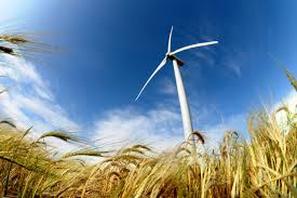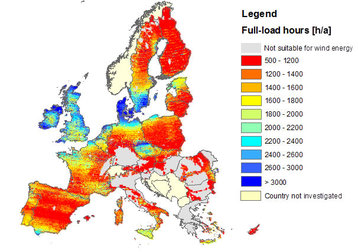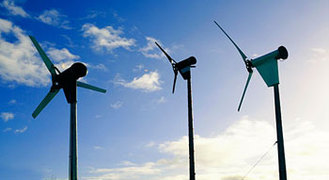Wind basics

There are currently 222 wind farms on the island of Ireland, 85% of which are based in the Republic of Ireland. These windfarms generate enough electricity to power the equivalent of 1,877,850 homes. To date, we have saved approximately one billion Euro in fossil fuel imports in Ireland through the development of our wind industry.
Historically, hydro power was the largest contributor to renewable electricity in Ireland. However, since 1990, wind energy production has increased so that it now accounts for over 80% of the renewable electricity generated in the country. Wind, hydro and biomass electricity accounted for 16.3%, 2.1% and 1.7%, respectively, of Ireland’s gross electricity consumption in 2013. It is clear that wind energy is a fast growing, global industry, but "just because everyone else is doing it" is not reason enough for Ireland to follow.
Why is Ireland focusing primarily on wind as our renewable energy solution?
 Spatial distribution of regional wind regimes in Europe. U.K., Ireland and Denmark possess favourable conditions for wind energy, while areas like Eastern Mediterranean are not favourable to wind energy.
Spatial distribution of regional wind regimes in Europe. U.K., Ireland and Denmark possess favourable conditions for wind energy, while areas like Eastern Mediterranean are not favourable to wind energy. There are accusations that industry is pushing the Irish government into over-development of the wind energy sector above other renewable resources. The reality is that, in Ireland, wind can make the most significant contribution to decarbonising our energy supply for the following reasons:
- Wind speed: Ireland possess some of the most favourable wind conditions and highest onshore wind speeds in Europe. This gives us a competitive advantage at harnessing a renewable energy resource whose feedstock is essentially limitless. Other renewables require resources (e.g. land, unique geology, biomass, large water systems) that are in less plentiful supply in Ireland.
- Environmental impact: The environmental impacts of wind energy are generally less problematic than other renewables. Wind turbines have the least impact on global warming compared to all other existing low carbon power sources. Only hydro power rivals wind with respect to its climate impact, but it suffers from the challenges of finding sites appropriate for dam construction and from impacts on fisheries and water quality. Unlike other renewables, wind farms do not compete with other land uses (e.g. food production) since turbine infrastructure occupies a relatively small area. There are also no waste products generated from wind energy production.
- Technological maturity: Globally, wind energy is the most technological mature and widely adopted of all the renewable technologies. Wind energy is more applicable and reliable than other forms of renewable energy (e.g. Wind has more potential operational hours than solar). This allows wind to be developed and maintained with greater ease and efficiency than other renewables.
- Cost competitiveness: Onshore wind is an inexpensive source of electricity that is competitive with, or cheaper than, fossil fuel plants. Wind power is capital intensive but has no fuel costs. The price of wind power is therefore much more stable than the volatility of fossil fuel prices. Wind turbines are also half the cost of solar panels per kWh. Only geothermal and hydro power rival wind in their levelized cost. However, the availability of appropriate locations of geothermal and hydro-electricity are far more restrictive than wind, particularly in Ireland.
Obstacles to providing wind energy
Aesthetics: Wind turbines are often criticised as having a significant visual impact on the landscape. This is a highly personal issue that confirms the belief that “beauty is in the eye of the beholder”. However, surveys of public attitudes across Europe and in many other countries show strong public support for wind power. A 2010 survey in Scotland demonstrated that 52% of respondents disagreed with the statement that wind farms are "ugly and a blot on the landscape" and 59% agreed that wind farms were necessary to meet current and future energy needs and how they looked was unimportant. Strong public consultation and community ownership are essential in overcoming negative opinions on the aesthetic impact of wind turbines.
Habitat impacts: Wind turbines can result in increased bird and bat mortality and interference with wildlife or sensitive habitats. Therefore, it is important not to locate wind farms near sensitive ecological sites. Incentives could be provided for wind farm developments to be located in areas other than the coast and uplands, such as intensive farmland or industrial areas, where wildlife impacts are likely to be less severe.
Human impacts: Wind turbines have been accused of causing adverse human health impacts, such as noise disturbance, electro-magnetic radiation and shadow flicker. The noise detected 300 metres from a wind turbine is slightly louder than a refrigerator. One mile from a wind turbine, it is inaudible. Peer reviewed research indicates there are no negative health effects from audible or sub-audible sound from wind turbines. Only shadow flicker, in which wind turbines cast long shadows when the sun is low in the sky, has been demonstrated to irritate residents living near wind turbines. Irish wind farm sites are not likely to encounter significant shadow flicker very often, but the potential for flicker can be calculated prior to construction and turbines can be sited to minimise impacts on local residents. Wind turbine software is also available to turn off the relevant turbines during shadow flicker events.
Why Wind? - Conclusion

Keep fighting the good fight!
-Cara
| If you like this post, please share it on Twitter or Facebook. Feel free to contact me through e-mail, Twitter, or Facebook with any climate-related questions you’d like to see addressed in future posts. Stay tuned next Friday for Climate Friday FAQ #5, when I'll tackle a reader's question: "Even if we stay under 2C of warming, could that trigger feedback loops that send us over?" |


 RSS Feed
RSS Feed